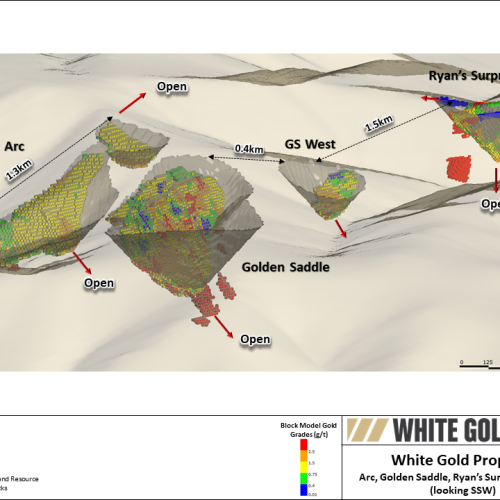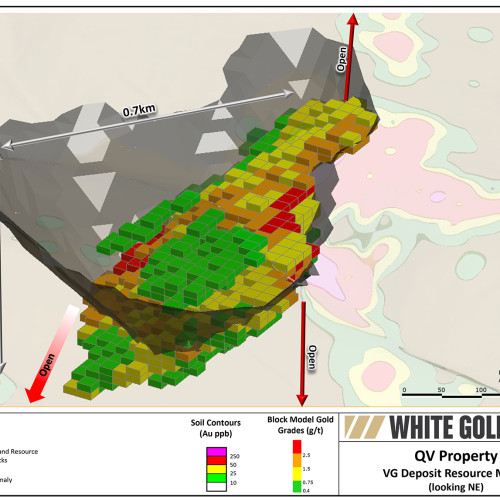Location & Access
Located on the White Gold property in west-central Yukon, within the Dawson Mining District, Canada, 95km south of Dawson City and 350km northwest of Whitehorse.
The Company’s flagship White Gold Project is located in west-central Yukon, within the Dawson Mining District, 95 km south of Dawson City and 350 km northwest of Whitehorse. The Project comprises four near-surface gold deposits, the Golden Saddle, Arc, Ryan’s Surprise, and VG. Access is provided by fixed wing airplane from Dawson City and Whitehorse to Thistle Creek airstrip and by boat from Dawson City to a barge landing on the Yukon River. The Company’s Thistle Camp is located at the southernmost part of the White Gold property and is the base of operations for all exploration. A gravel road that is used extensively by placer miners connects the camp with the airstrip and barge landing, which are located approximately 7.5 km east and 4.5 km northwest respectively of the camp. Access to the Golden Saddle and Arc deposits to the north is provided by a 21 km long exploration road located 600 m west of camp. The Ryan’s Surprise and VG deposits are located 2 km west and 11 km north respectively of the Golden Saddle deposit and are accessible only by helicopter.
Size
2,795 claims covering approximately 55,000 hectares
Work to Date
Target (Mineralization)
Orogenic gold deposits
Overview
Golden Saddle Deposit
The Golden Saddle deposit consists of the GS Main, GS Footwall and GS West zones and together the zones define mineralization over a 1,500 m strike length and up to 725 m down dip. Currently, the GS Main is the most significant zone in terms of estimated ounces and overall grade; containing approximately 95% of the Indicated ounces within the overall Golden Saddle deposit.
Gold mineralization at the Golden Saddle deposit is hosted in a metavolcanic and metaintrusive assemblage broadly consisting of felsic orthogneiss, amphibolite, and ultramafic units. Gold generally occurs as micron-scale blebs along fractures or encapsulated by pyrite, and as visible gold (less than 5 mm in size) located as free grains in quartz. Mineralization is present in quartz veins and stockwork or breccia with disseminated pyrite. Drill hole intersected gold mineralization is spatially co-incident with structures, or faults which are interpreted to be the primary conduits for hydrothermal fluids responsible for gold deposition. The thicknesses of the mineralization and breccia zones are variable from 5 m to over 50 m, as they pinch and swell along strike. A consistent higher-grade core (> 3 g/t Au) occurs within the main zone at Golden Saddle. Gold mineralization at the Golden Saddle deposit remains open in all directions and is known to extend beyond the limits of the current resource estimate, however, the mineralization in these areas does not currently meet the criteria to be classified as Mineral Resources.
Arc Deposit
The Arc deposit is located approximately 400 m south of the Golden Saddle and consists of two zones, the Arc Main and Arc Footwall zones, both have an arcuate shape, trending E-NE and dip to the north at approximately 50 degrees. Mineralization at the Arc has been defined over 1,200 m in strike length and up to 450 m down dip with mineralization open along strike and down dip. Gold mineralization at the Arc deposit is less well understood than the Golden Saddle, which is partially a function of drilling at the Arc deposit being more widely spaced. Gold mineralization is hosted within a metasedimentary sequence dominated by banded (graphitic) quartzite and interbedded pelitic biotite schist that is cross-cut by numerous felsic to intermediate dykes and sills.
Gold mineralization appears to be focused within breccia and shear zones that have been affected by hydrothermal alteration and sulphide mineralization. Drilling has defined an upper main zone as well as a lower footwall zone of anomalous gold but of lesser tenor than the main upper zone. Mineralization remains open to the east, west and at depth. The occurrence of gold at Arc appears to be associated with disseminated and veined pyrite, arsenopyrite, and graphite.
Ryan’s Surprise Deposit
Ryan’s Surprise is located 2 km west of the Golden Saddle deposit, along a 6.5 km long x 1 km wide north-northwest trend of anomalous gold and arsenic in soils known as the “Ryan’s Trend”. This trend hosts several other prospective early-stage targets with significant surface gold mineralization, highlighting the broader potential for the project’s expansion. Gold mineralization at the Ryan’s Surprise deposit is primarily hosted within a metasedimentary sequence dominated by banded (graphitic) quartzite and interbedded pelitic biotite schist cross-cut by numerous felsic – intermediate dykes and sills.
Gold mineralization appears to be focused within steeply southwest dipping breccias and shear zones that have been affected by hydrothermal alteration and sulphide mineralization. Recent drilling has defined multiple subparallel zones that are host to gold-bearing sulphide mineralization including arsenopyrite and pyrite, and range in true width from < 1 m to in some instances, > 10 m. The mineralization footprint at the Ryan’s Surprise deposit measures approximately 550 m north-south by 500 m east-west, extends to a vertical depth of 650 m and remains open along strike and at depth. The occurrence of gold at Ryan’s Surprise has not been evaluated, and no metallurgical testwork has been undertaken to understand the possible gold deportment. However, the host rocks, alteration and sulphide mineralization display many similarities to the Arc deposit.
VG Deposit
The VG deposit is located approximately 11 km north of the Golden Saddle deposit. Gold mineralization at the VG deposit is hosted in moderately northwest dipping quartz ± carbonate veins, stockwork and breccia zones, and pyrite veinlets, including cubic pyrite and visible gold, associated with intense-quartz-carbonate-sericite alteration, pervasive K-spar and hematite emplaced along en-echelon faults or shear zones. Visually, the style of gold mineralization and alteration appears identical to the Golden Saddle deposit, along with similar dominant host rocks of biotite-feldspar (± augen)-quartz gneisses. To date, no metallurgical testwork has been performed on the VG mineralization, however given its close similarities to Golden Saddle, gold recoveries are assumed to be similar. Opportunities exist at the VG deposit to quickly upgrade a significant portion of Inferred Resources to Indicated, as well as for expansion of gold mineralization at depth and along strike. There are also several other prospective targets on the property which have received limited exploration work and offer potential for additional discoveries.




